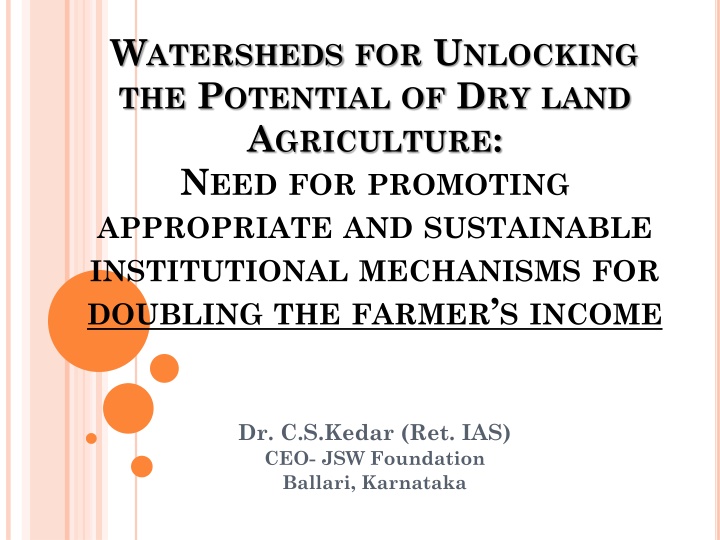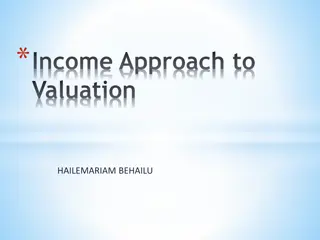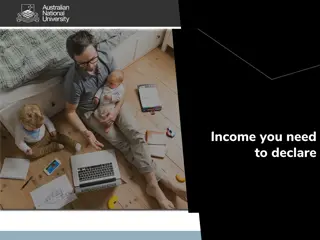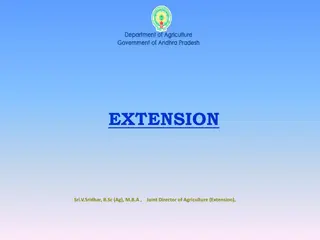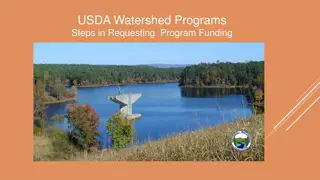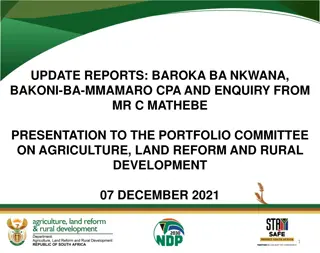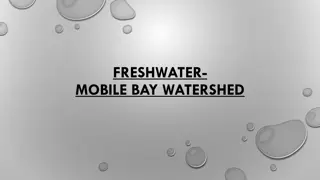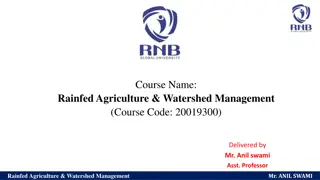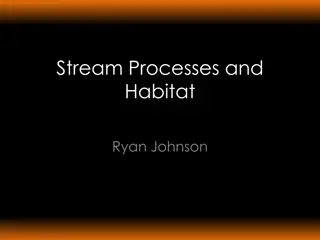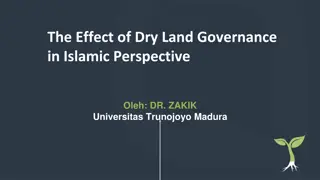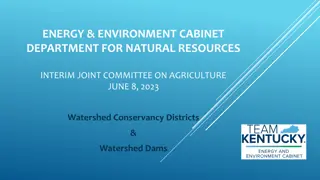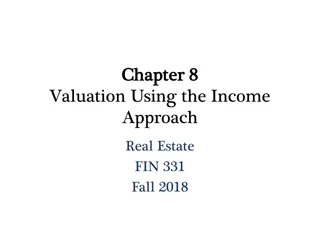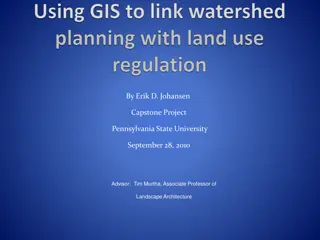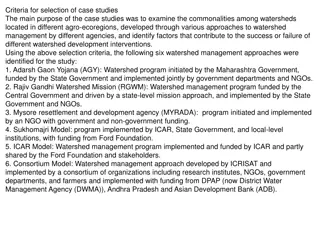Unlocking Dry Land Agriculture Potential: Doubling Farmer Income through Watershed Approach
Dr. C.S. Kedar emphasizes the importance of promoting appropriate institutional mechanisms to double the income of dryland farmers through watershed-centric approaches. The proposed method focuses on aggregating goods and services, leveraging markets, and accessing government schemes. Key elements include forming Women Farmer Producer Organizations, linking with various stakeholders, and providing services like credit support, marketing assistance, and agricultural training. By implementing these strategies, sustainable development in dryland agriculture can be achieved.
Download Presentation

Please find below an Image/Link to download the presentation.
The content on the website is provided AS IS for your information and personal use only. It may not be sold, licensed, or shared on other websites without obtaining consent from the author.If you encounter any issues during the download, it is possible that the publisher has removed the file from their server.
You are allowed to download the files provided on this website for personal or commercial use, subject to the condition that they are used lawfully. All files are the property of their respective owners.
The content on the website is provided AS IS for your information and personal use only. It may not be sold, licensed, or shared on other websites without obtaining consent from the author.
E N D
Presentation Transcript
WATERSHEDS FOR UNLOCKING THE POTENTIAL OF DRY LAND AGRICULTURE: NEED FOR PROMOTING APPROPRIATE AND SUSTAINABLE INSTITUTIONAL MECHANISMS FOR DOUBLING THE FARMER S INCOME Dr. C.S.Kedar (Ret. IAS) CEO- JSW Foundation Ballari, Karnataka
THIS IS AN APPROACH INSPIRED BY THE JSW ICRISAT PILOT
SALIENT FEATURES OF THE PROPOSED APPROACH: WATERSHED CENTRIC FOR DRY LANDS ONLY TECHNOLOGY NEUTRAL PEOPLES ORGANISATIONS PEOPLES CONTRIBUTION CONSORTIA APPROACH LEVARAGING MARKETS
IFTHEQUESTIONISTODOUBLETHEINCOME OFDRYLANDFARMERS, THEN aggregating goods & service needs of the watershed community in line with market forces, and helping the community to leverage collectively holds key to the success!!
a) Aggregating and leveraging from the market following goods and services.. Land improvement Expert s advise Credit needs Inputs like quality seeds, weedicides, soil nutrients, etc., Formulated Fertilizers Agricultural implements Crop and animal insurance Agro products marketing support Soil health analysis THROUGH SYSTEMATIC BUILDING OF INSTITUTIONS
b) Accessing and leveraging the Government schemes and services through linking with Raitha Samparka Kendras Raita Sahayawani (Farmers Helplines) KVK / UAS MNREGA PRIs Programmes/Schemes of the Agriculture Department Crop and livestock insurance
AGGREGATINGGOODS & SERVICES: -SCOPEFORA WATERSHED LEVEL WOMEN FARMER S PRODUCER ORGANISATION (FPO) OWNED FARMER S SERVICE CENTER (FSC) Information, Guidance & Training on Technologies, Govt. schemes & services (IGT) Quality Supply of Agri-Inputs (QSAI) FSC Assured Credit Support (ACS) Farm-Products Marketing Support (FPMS) Agricultural Processes Outsourcing (APO)
LINKAGES ICRISAT / UAS / KVK, Govt Departments, PRI Corporate Sector QSAI IGT FSC/FPO ACS FPMS APM Network Banking Sector APO Skilled Labor Groups / Service Agencies
COMPONENTS FSC/FPO levels Proposed Institutions Watershed Level One Women FPO/FSC would be promoted; Woman Head of the house-hold from every watershed families would become eligible to be a members of the FPO/FSC (Avr. 8000 ha) Village Level Village Resource Center (VRCs) - With a specific objective of promoting linkage with the Govt. and its infrastructure (including employment programmes not directly related to agriculture) (at each revenue villages in the watershed) Informal Interest Group Level Women Self Help Groups (SHGs ) Farmer s Joint Liability Groups (JLGs) Farmers Field Schools (FFSs) Note: VRC functions as a sub-unit of FSC at village level and all the Interest Group (IGs) are affiliated to respective VRCs
Women FPO / FSC District Level Watershed P&M Cell Taluka Level Watershed Level (8000 Ha.) Women FPO/ FSC Village / Community Level ( 4-10 villages) JLGs W-SHGs FFS VRC House-Hold Level (2,400) 24o Man Head-of-the HH Woman Head of the HH
But, Why Watershed .?!
Learnings from Command Area: Parameters Distinct Geography CADA* WADA** Command Area Watershed Area (area within the ridge-line) Scanty Rain water Binding Factor Copious Canal water Usage Pattern Flood irrigation SOAKING rain , enhancing soil & moisture conservation, harvesting, using ground water judicially through pot irrigation, drip, sprinkler, etc., even if from tube-well / open-well sources Crop diversification, focus on food crops and low external inputs approach rain water Tendency Heavy cropping, preference, external driven approach Better established. Thanks to scale of operations duty cash and inputs Mono- crop high yield Aggregation of the goods & services Lack completely; Compulsion to aggregate * Command (Canal) Area Development Approach ** Watershed Area Development Approach
Why FPO ?... and Women heading it ??...
FSC/FPO PLAYS A GREATER ROLE AS A NETWORKER LINKING FARMER S NEEDS WITH RESOURCES, SCHEMES & SERVICES OF THE LOCAL GOVERNMENT, COOPERATIVES, CORPORATE AND PUBLIC INSTITUTIONS
A FARMER S SERVICE CENTER (FSC) CAN AVAIL SERVICES OF LOCAL Women Self Help Groups CO-OPERATIVES COMPANIES BANKS NBFCs MFIs
Why women? Women Headed SHGs have succeeded in all sectors Women Banks have proved highest recoveries Over 75% of agro activities are performed by women. 80% of allied and non-farm activities such as diary, fisheries, handicrafts in rural areas are carried out by women The proposed intervention would lead to the empowerment of women
WATERSHED TECHNOLOGY ICRISAT has already developed and proven on the ground. The same set of technologies would be used towards treating the watershed development
Doubling the dry land farmers income Core Strategy: Redefining farming norms and practices through a continued and consistent engagement of the key-stake holders!! Cadre of Samudaya Prerakas (Community Motivators) The CSR Watershed Development Project FSC (Farmer s Service Center)
FUND REQUIREMENT Rs. 24,000 per Ha. - With 50 % Community Contribution* *Community contribution includes farmer s contribution towards the watershed development in the form of cash, kind, labor, loan from their Banks and collective contribution from the watershed community, PLUS resources mobilised from the Government schemes and other sources Total coverage 8000 Ha per project area.
Consortia approach: Lead Partner -strategic planning & monitoring Technology Partner -ICRISAT Co- Partner -Watershed treatment structures Processes Facilitating Partner IBIT* Partner -NGO Banking Partner -Financing farmers *Institutions Building & Information Technology (IBIT) CBO Partner: Women FPO Farmer s Service Centre (FSC) The Watershed Community
PARTNERS RESPONSIBILITIES Institutions Responsibilities Overall roll-out, strategic planning, monitoring, reviews and evaluations, and funding institutions building processes Lead Partner Funding watershed area treatment and technologies Co-Partner Appropriate Technologies, training in planning and extension, plan approvals, feed back -Community mobilization and ; -promotion of SHGs, JLGs, FFS. -Establishing FPO/FSC/VRCs - Roll-out Krish-Kutumba Suraksha Yojana as an entry point activity. -Pro-active Banker to extend credit linkage to SHGs, JLGs, individual farmers and FPO/FSC/VRC Technology Partner A reputed NGO -IBIT Partner Banking Partner -Principle stake-holder; owns & manage FSC and VRCs; -Mobilise 50% contribution; -Plan, implement and monitor watershed action plan by WDMC Women-FPO - CBO Partner Leading vision, mission and specific goals driven participative processes Overall engaging all the stake-holders pro-actively and Process facilitation and documentation Processes Facilitating Partner -Co-ordinating & networking
Budget Inflow 19.2 crores over 5 years Lead Partner 25% Co- Partner: 25% Technology Partner Processes Facilitating Partner Banking Partner: 25%* IBIT Partner Women FPO/FSC: 25%** Note: *in the form of loans to the farmers ** collecting direct contribution from farmers Community contribution is as high as up to 50% *25% in the form of loans taken by the farmers ** 25% direct contribution collected by FPO
Budget Out-flow 19.2 crores over 5 years Lead Partner Technology Partner 5% Co- Partner Processes Facilitating Partner 5% IBIT Partner 20% Banking Partner Women FPO 70% Note: Community is spending up to 70% directly
PROJECT IMPLEMENTATION PERIOD ( 5 YEARS) Stages Name Duration* I Preparatory(Forming & Norming) Stage 1 Year II Performing Stage 3 Years III Consolidation and Sustenance Stage 1 Year *No- cost extension period of max. 2 years could be allowed to the NGO and Technology Partners if necessary
% OF TOTAL BUDGET & SOURCE 5% EXECUTION Through ACTIVITIES Preparatory Stage (Forming & Norming); Entry point Activities (Family Food & Financial Security Schemes) NGO, FPO & Bank Partner -PME Process Facilitation and documentation -Community & Institutions capacity building - Technology transfer Performance Stage Soil & water conservation structures, production systems and livelihood options 5% 10% 5% 50% IID NGO ICRISAT FPO (WD&MC) -Farmer s Service Center (FSC) Services -Village Resource Center (VRC) Services Consolidation Stage - Institutionalizing FPO, FSC, VRC, SHG, JLG and FFS relationship, and linkages with corporates, Govtnt departments and other resource agencies 15% 5% FPO FPO 5% FPO
STEPSINVOLVED Training by ICRISAT on action plan preparation Prepare a draft plan for the selected area Seeking technical approval Seeking administrative approval people s participation, mop-up trains master trainers entry point activity and promotes social structures Implementation of farm level structures & crop practices Mid-course Corrections Monitoring by Project Steering Committee Documentation Monitoring & Evaluation (M&E)
SUSTAINABILITY. A vibrant Women FPO/FSC with around 2,400 members, 240 SHGs, and Village Resource Centres at EVERY revenue villages; imparting 5 kinds of services with a team of 40 members; annual turn-over reaching Rs 5-10 crores, and self-sustained in meeting all it s costs and preferably making profits. All members of FPO/FSC would be meeting every fortnight and discussing collectively on; managing their savings, 5 levels of credit needs, farming operations, and Family Development Plans. Skilled facilitator from FSC/FPO would be facilitating group processes. The Executive Committee of the FPO/FSC would be meeting every month and reviewing the performance of the FPO/FSCs and VRCs The General Council of the FPO/FSC would be meeting every quarter and taking stock of the self-auditing and self-accountability processes The General Body would be meeting once year and electing EC, and GC, and approving the annual expenditure statement and budgets
CONCLUSION & RECOMMENDATION
CONCLUSIONS Watershed development approach can unlock the potential of dry land agriculture effectively. However, there is a need to promote appropriate and sustainable institutional mechanisms for doubling the farmer s income 1) Aggregating the goods and service needs of the farmers at the watershed level, and aligning them in line with market forces through a systematic institution building holds key to success. 2) A better approach for aggregating such goods & services is by helping the communities to have Women SHGs centered FPOs, enabling them to set-up and manage Farmer s Service Centers (FSCs) and leverage collectively with market forces 3)
CONCLUSIONS (CONT) As the challenge includes redefining farming norms and practices , managing institutions and dealing with market forces, it requires a continued and consistent engagement of all the related key-stake holders. Therefore a consortia approach has to be adopted in execution of such a model. 4) Once the proof of the concept is established in a pilot watershed (around 8000 Ha), a blueprint has to be laid down on doubling the farmers income, and rolling out appropriate mechanisms for scaling-up in target eco-regions 5) The model should be based on business principles, where the local community has to have a major stake in terms of cost sharing and the benefit sharing 6)
RECOMMENDATION (1) As the proposed model is aimed at capacitating communities to redefine farming norms and practices at one end, and leveraging and linking with market forces and the Government on the other, it calls for a continued and consistent engagement of all the key-stake holders involved. Therefore it is recommended to have a consortia approach for implementing such intervention
RECOMMENDATION(2) In any given agro eco-region, first proof of the concept has to be established on a pilot watershed, and a blueprint of doubling the farmer s income has to be developed and demonstrated to the local community as the approach proposes a relatively high level of engagement of the local community; almost up to 50% cost contribution, and 70% direct expenditure by the Women FPO.
